Yamaha A-S1000 User Manual [ru]
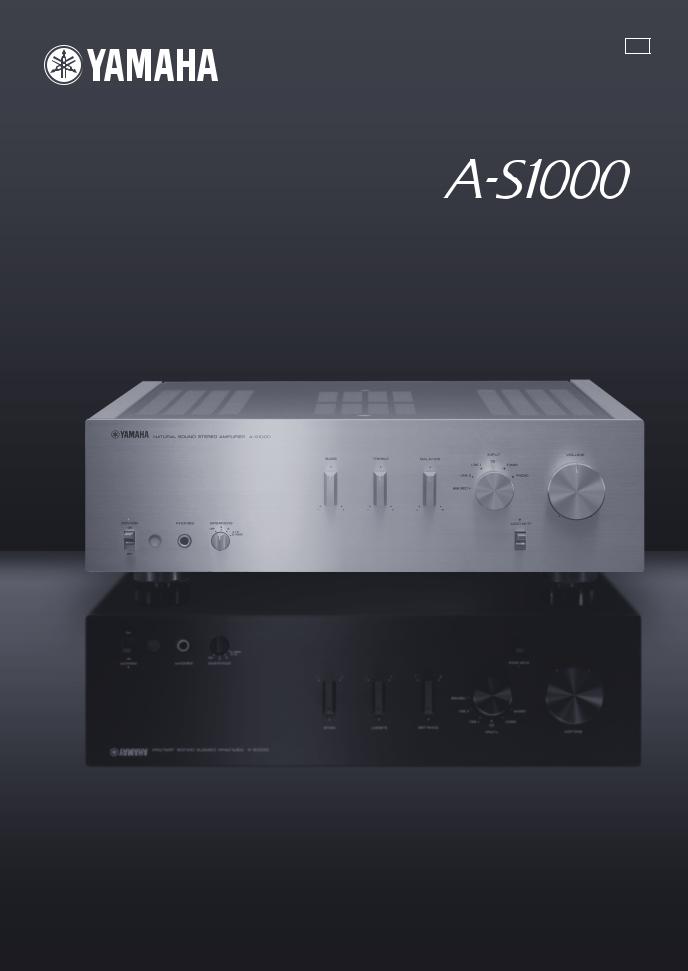
G
Stereo Amplifier
Amplificateur Stéréo
OWNER’S MANUAL MODE D’EMPLOI BEDIENUNGSANLEITUNG BRUKSANVISNING MANUALE DI ISTRUZIONI
MANUAL DE INSTRUCCIONES
GEBRUIKSAANWIJZING
ИНСТРУКЦИЯ ПО ЭКСПЛУАЦИИ
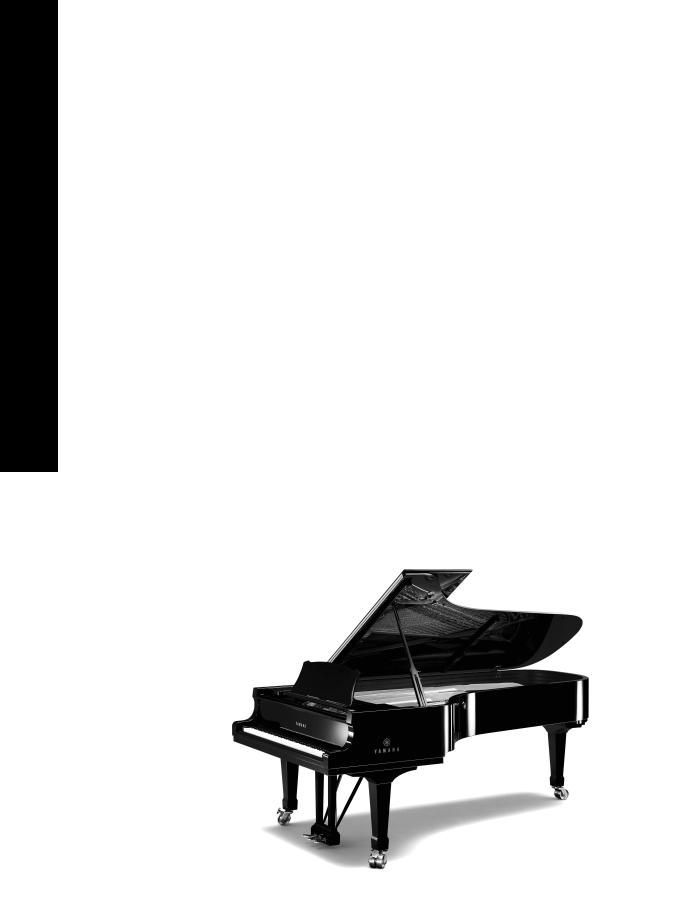
HiFi Began with Yamaha
Yamaha’s involvement with and passion for music goes back more than a century, to when we built our first reed organ in 1887. Now we are the world’s leading producer of pianos and other musical instruments, and are involved with music in many other ways as well. We manufacture professional recording equipment, we design concert halls and we assist artists at concerts with set up and sound tuning.
This knowledge and experience benefits our production of audio components in many ways. We introduced our first HiFi (High Fidelity) turntable in 1955. Thereafter we were one of the first to offer mass-produced, high quality audio equipment,
and introduced many legendary stereo components.
We hope you enjoy the genuine HiFi experience of Yamaha Natural Sound.
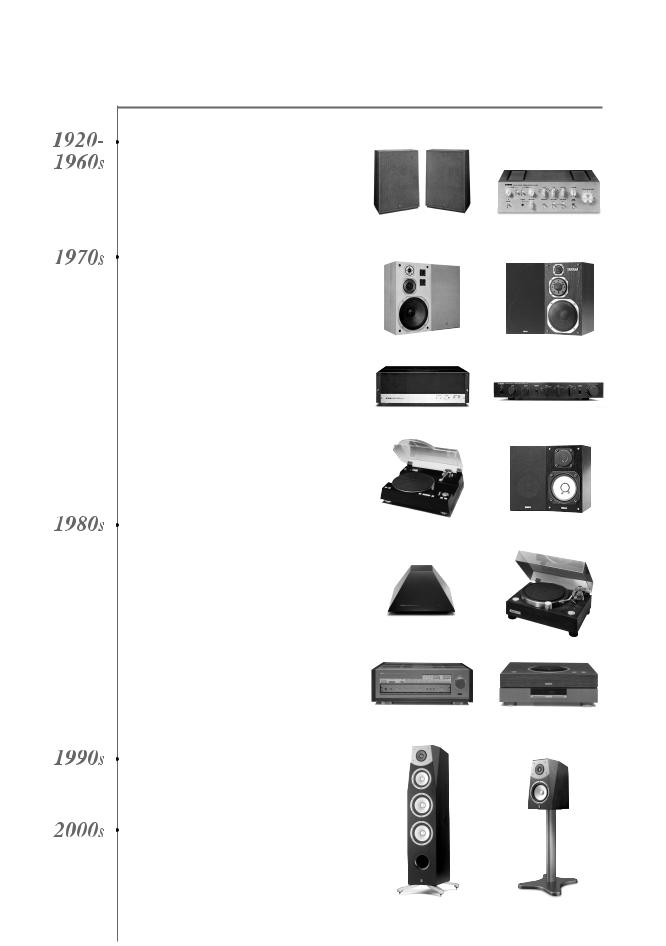
Excellence in Audio Achievement
1922: We introduced a high-quality handwound phonograph.
Since 1955, we have released many HiFi components, including turntables, tuners, integrated amplifiers, control amplifiers, power amplifiers and speakers.
NS-20 Monitor Speaker
CA-1000 Integrated Amplifier
Featuring A-Class operation, the CA-1000 set the standard for integrated amplifiers.
NS-690 Monitor Speaker
NS-1000M Monitor Speaker
A truly legendary speaker still revered by HiFi enthusiasts
B-1 Power Amplifier
An innovative power amp that used FETs in all stages
C-2 Control Amplifier
Received top prize at the Milan International Music and HiFi Show.
NS-20 |
CA-1000 |
NS-690 |
NS-1000M |
B-1 |
C-2 |
NS-10M Studio Monitor Speaker
Became of the most popular studio monitors in the world.
A-1 Integrated Amplifier
PX-1 Turntable
Yamaha’s first linear tracking turntable
B-6 Power Amplifier |
PX-1 |
|
Pyramid-shaped power amplifier with X power supply and X amplifier
GT-2000/L Turntable
Ultra-precise heavyweight player embodying GT concept
CD-1 CD Player
First CD Player introduced in 1983
B-6
B-2x Power Amplifier
MX-10000 Power Amplifier and CX-10000 Control Amplifier
Amplifier that redefined the capabilities of separate components
100th anniversary model
AX-2000
AX-2000 Integrated Amplifier
High S/N ratio (128 dB), digital direct function equipped
GT-CD1 CD Player
Top-loading type player with integrated separate structure
MX-1 Power Amplifier and CX-1 Control
Amplifier
Soavo-1 and Soavo-2 Natural Sound
Speaker Systems
A-S2000 Stereo Amplifier and
CD-S2000 Super Audio CD Player
A-S1000 Stereo Amplifier and
Soavo-1
CD-S1000 Super Audio CD Player
NS-10M
GT-2000
GT-CD1
Soavo-2
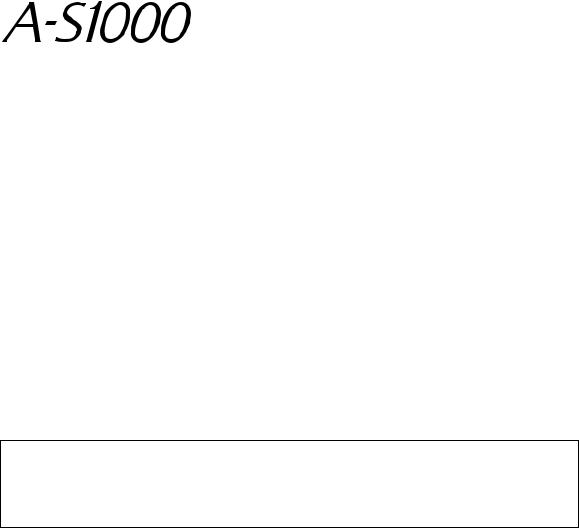
Floating balanced circuit design
The perfectly symmetrical, fully new floating balanced power amplifier maximizes the performance of the analog amplifier.
Parallel volume and tone control
Four independent high capacity power supplies
Horizontally symmetrical structure
Phono amplifier with fully discrete structure
Newly developed heavyweight feet to suppress vibrations
■ |
Supplied accessories |
|
Please check that you have received all of the following parts. |
|
|
• |
Remote control |
|
• Batteries (AA, R6, UM-3) (×2) |
|
|
• |
Power cable |
|
• |
Safety brochure |
|
Contents |
|
|
|
Controls and functions.......................................................................................................................................... |
6 |
|
Connections.......................................................................................................................................................... |
14 |
|
Specifications ....................................................................................................................................................... |
20 |
|
Troubleshooting................................................................................................................................................... |
24 |
■ About this manual
•yindicates a tip for your operation.
•This manual is printed prior to production. Design and specifications are subject to change in part as a result of improvements, etc. In case of differences between the manual and the product, the product has priority.
•The color of images in this manual may vary from the original.
•Read the “Safety brochure” before using this unit.
4 En
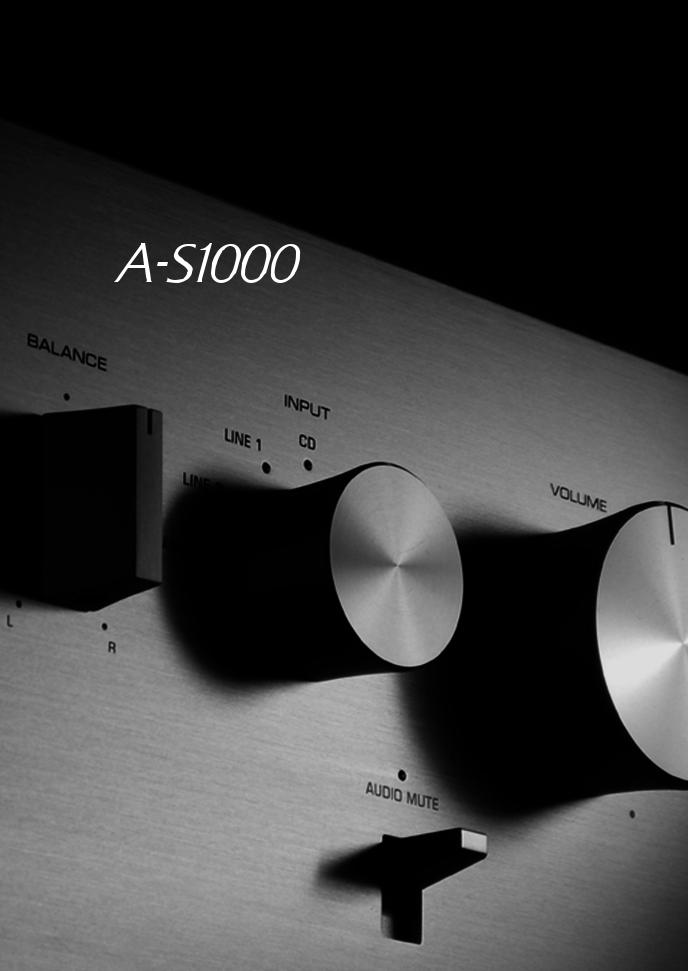
Controls and functions
In this chapter, you will learn the controls and functions of A-S1000.
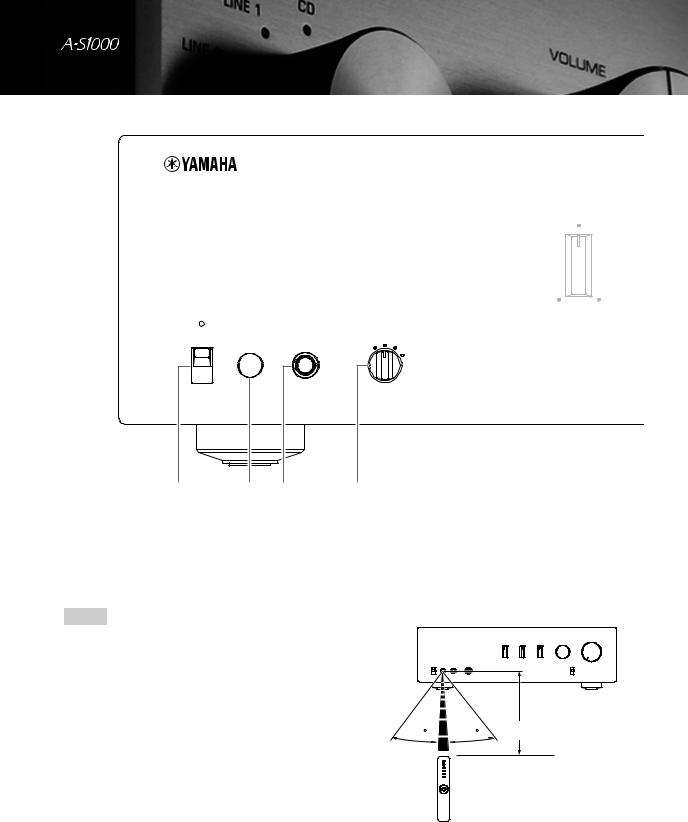
Controls and functions
■ Front panel (left side)
POWER |
|
PHONES |
ON |
|
|
OFF |
|
|
1 |
2 |
3 |
1 POWER
Press upward or downward to turn on or off this unit.
y
The POWER indicator above lights up when this unit is turned on.
Notes
•If the POWER indicator flashes when you turn on this unit, disconnect the power cable and refer to the troubleshooting section (page 24).
•When you turn on this unit, there will be a few second delay before this unit can reproduce sound.
BASS
- |
+ |
SPEAKERS
A
OFF B
A+B
BI-WIRING
4
2 Remote control sensor
Receives signals from the remote control.
y
The remote control transmits a directional infrared beam. Be sure to aim the remote control directly at the remote control sensor on the front panel of this unit during operation.
Within 6 m (20 ft)
30 30
6 En
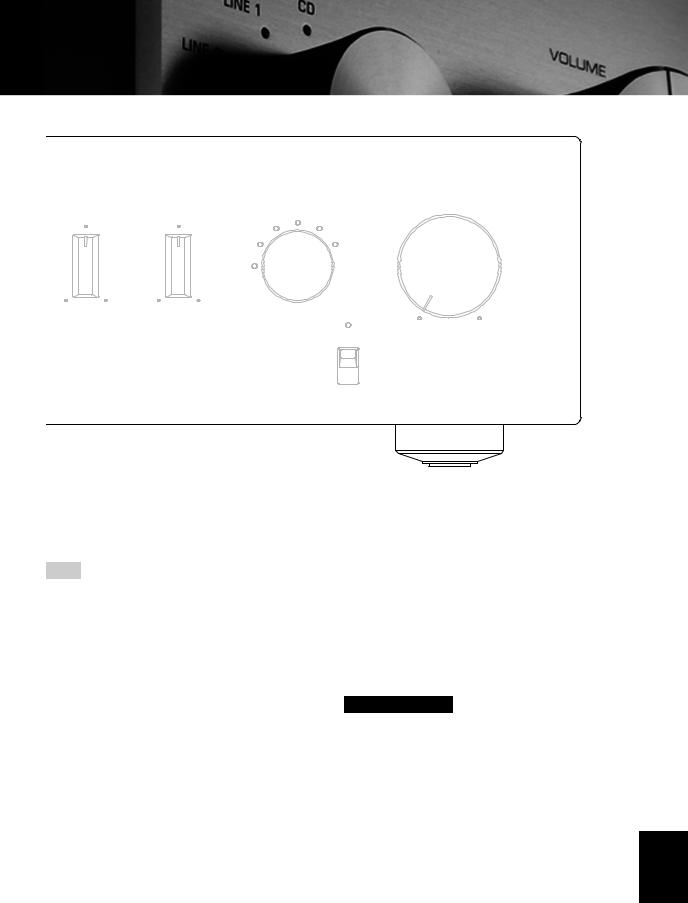
|
|
|
INPUT |
VOLUME |
|
TREBLE |
BALANCE |
CD |
|
|
|
|
TUNER |
|
|
|
|
LINE 1 |
|
|
|
|
LINE 2 |
PHONO |
|
|
|
MAIN DIRECT |
|
- |
+ |
L |
R |
|
|
|
|
|
AUDIO MUTE |
3 PHONES jack
Outputs audio for private listening with headphones.
Note
When headphones are plugged in:
–Both speaker sets connected to the SPEAKERS L/R CH A and B terminals are turned off.
–No signals are output at the PRE OUT jacks, while signals are output at the REC jacks.
–You cannot select MAIN DIRECT as the input source.
–If headphones are plugged into the PHONES jack while MAIN DIRECT is selected as the input source, no audio is output at the PHONES jack. Use the headphones jack of the preamplifier connected to the MAIN IN jacks.
4 SPEAKERS
Turns on or off the speaker set connected to the SPEAKERS L/R CH A and/or B terminals on the rear panel.
•Switch to the OFF position to turn off both speaker sets.
•Switch to the A or B position to turn on the speaker set connected to the SPEAKERS L/R CH A or B terminals.
•Switch to the A+B BI-WIRING position to turn on both speaker sets.
Caution
If you use two sets (A and B), the impedance of each speaker must be 8 Ω or higher. When only using one set of speakers (A or B), use speakers with an impedance of 4 Ω or higher.
English
7 En
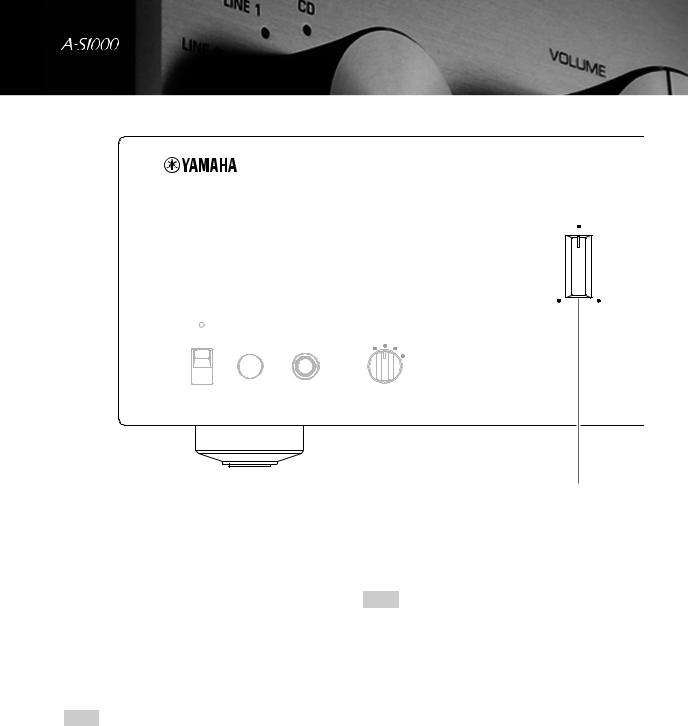
Controls and functions
■ Front panel (right side)
BASS
- |
+ |
POWER |
PHONES |
SPEAKERS |
||
ON |
|
OFF |
A |
B |
|
|
|
||
A+B
BI-WIRING
OFF
5
5 BASS
Increases or decreases the low frequency response. The center position produces a flat response.
Control range: –9 dB to +9 dB
6 TREBLE
Increases or decreases the high frequency response. The center position produces a flat response.
Control range: –9 dB to +9 dB
y
When both the BASS and TREBLE controls are set to the center position, audio signal bypasses the tone control circuitry.
7 BALANCE
Adjusts the audio output balance of the left and right speakers to compensate for sound imbalances caused by speaker locations or listening room conditions.
Note
The BALANCE control does not affect the signals input at the MAIN IN jacks (INPUT selector: MAIN DIRECT) and signals output at the REC OUT jacks.
Note
The BASS and TREBLE controls do not affect the signals input at the MAIN IN jacks (INPUT selector: MAIN DIRECT) and signals output at the REC OUT jacks.
8 En
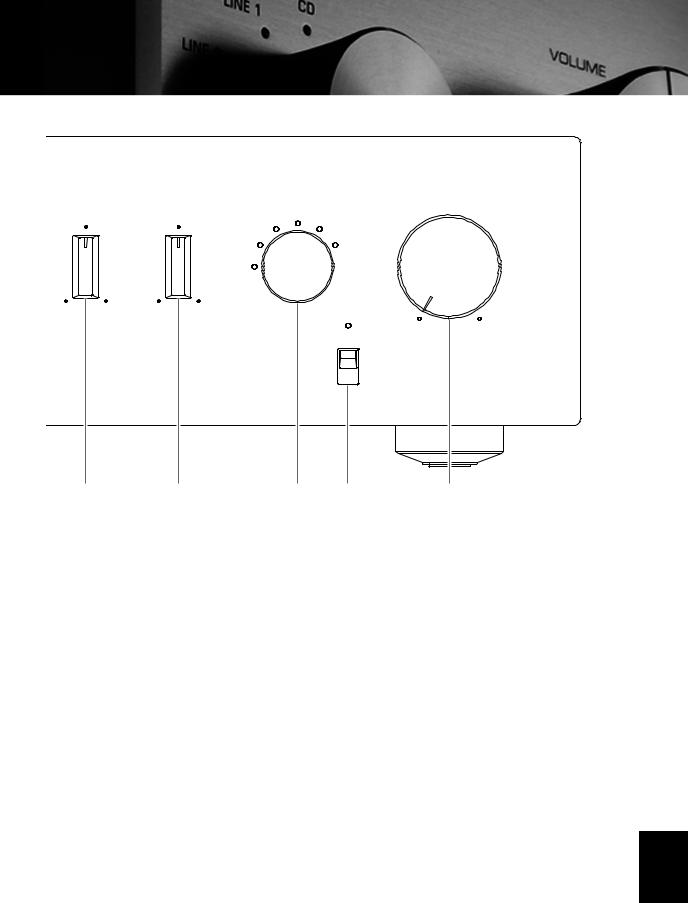
|
|
|
INPUT |
VOLUME |
|
TREBLE |
BALANCE |
CD |
|
|
|
|
TUNER |
|
|
|
|
LINE 1 |
|
|
|
|
LINE 2 |
PHONO |
|
|
|
MAIN DIRECT |
|
- |
+ |
L |
R |
|
|
|
|
AUDIO MUTE |
|
6 |
7 |
8 |
9 |
0 |
8 INPUT selector
Selects the input source you want to listen to.
The audio signals of the selected input source are also output at the REC jacks.
y
•The input source names correspond to the names of the connection jacks on the rear panel.
•Switch to the MAIN DIRECT position to select the component connected to the MAIN IN jacks. When MAIN DIRECT is selected as the input source, no signals are output at the PRE OUT, REC, and PHONES jacks.
•The input setting is retained for about 1 week after the power is turned off.
9 AUDIO MUTE
Press downward to reduce the current volume level by approximately 20 dB. Press again to restore the audio output to the previous volume level.
y
•The AUDIO MUTE indicator lights up while the mute function is on.
•You can also rotate VOLUME on the front panel or press VOL +/– on the remote control to resume the audio output.
0 VOLUME
Controls the volume level. This does not affect the REC level.
Note |
|
Note |
The audio signals are not output at the REC jacks while LINE2 is selected as the input source.
The VOLUME control does not affect when you select MAIN DIRECT as the input source. Adjust the volume level using the volume control on the preamplifier connected to the MAIN IN jacks.
English
9 En
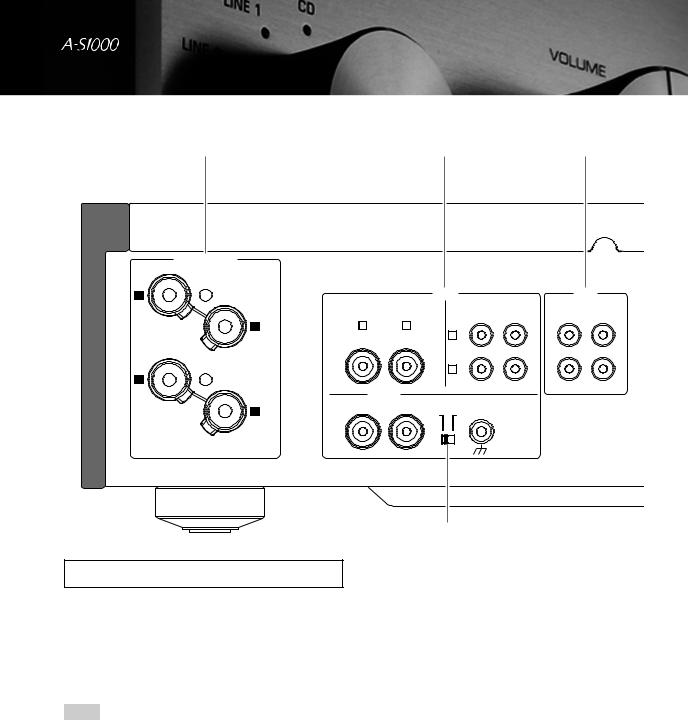
Controls and functions
■ Rear panel
1 |
2 |
3 |
SPEAKERS R CH |
|
|
|
A |
INPUT |
|
LINE2 |
CD |
TUNER LINE 1 |
PB |
REC |
R |
L |
|
|
|
L |
|
|
R |
B |
|
|
|
PHONO |
|
|
MM |
MC |
|
|
GND |
|
|
9 |
See page 14 for connection information.
1SPEAKERS L/R CH terminals
2INPUT jacks
3LINE2 jacks
4MAIN IN jacks
Note
Adjust the volume level using the volume control on the preamplifier connected to the MAIN IN jacks when you select MAIN DIRECT as the input source.
5 PRE OUT jacks
y
•When you connect audio pin plugs to the PRE OUT jacks to drive the speakers using an external amplifier, it is not necessary to use the SPEAKERS L/R CH terminals.
•The signal output at the PRE OUT jacks are affected by the BASS and TREBLE settings.
•The PRE OUT jacks output the same channel signal as the SPEAKERS L/R CH terminals.
•When you use a subwoofer, connect it to the PRE OUT jacks and speakers to the SPEAKERS L/R CH terminals.
10 En
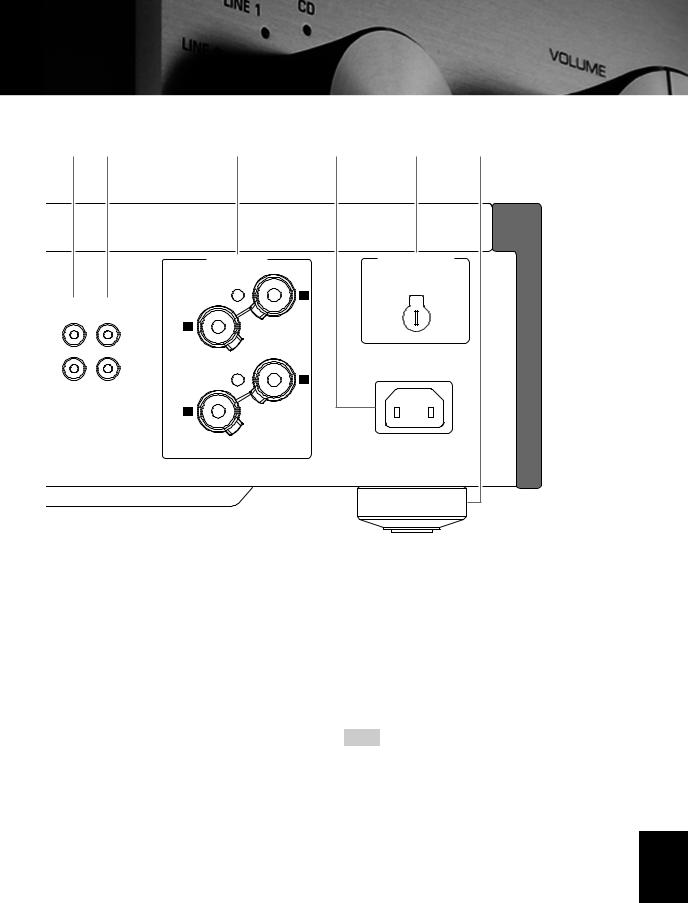
4 |
5 |
1 |
6 |
7 |
8 |
|
|
SPEAKERS L CH |
|
VOLTAGE SELECTOR |
|
MAIN IN PRE OUT |
A |
|
230- |
|
|
|
|
240V |
|
||
|
|
|
|
||
|
|
B |
|
AC IN |
|
|
|
|
|
|
|
6 AC IN
Use this inlet to plug in the supplied power cable.
7VOLTAGE SELECTOR
(Asia and General models only)
The VOLTAGE SELECTOR on the rear panel of this unit must be set for your local main voltage BEFORE plugging the power cable into the AC wall outlet. Improper setting of the VOLTAGE SELECTOR may cause damage to this unit and create a potential fire hazard.
Rotate the VOLTAGE SELECTOR clockwise or counterclockwise to the correct position using a straight slot screwdriver.
Voltages are as follows:
............................ AC 110/120/220/230–240 V, 50/60 Hz
8 Foot
If this unit is unstable, you can adjust the foot height by rotating it.
9 PHONO
Selects the type of magnetic cartridge of the turntable connected to the PHONO jacks on the rear panel.
•Set to the MM position when the connected turntable has a moving magnet (MM) cartridge.
•Set to the MC position when the connected turntable has a moving coil (MC) cartridge.
Note
When you replace the cartridge, be sure to turn off this unit.
English
11 En
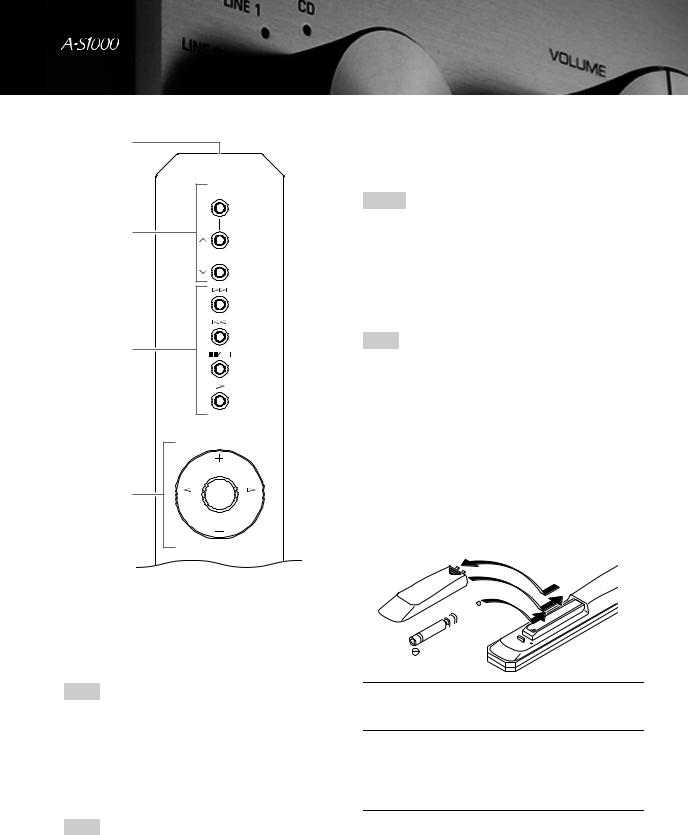
Controls and functions
■ Remote control
1
A/B/C/D/E
2
PRESET
3
|
|
VOL |
|
4 |
INPUT |
MUTE |
INPUT |
|
|
VOL |
|
1Infrared signal transmitter
Outputs infrared control signals.
2Yamaha tuner control buttons
Control functions of Yamaha tuner. Refer to the owner’s manual of your tuner for details.
Note
Not all Yamaha tuners can be controlled by this remote control.
3 Yamaha CD player control buttons
Control various functions of Yamaha CD player. Refer to the owner’s manual of your CD player for details.
y
Press 
 once to pause and twice to stop playback.
once to pause and twice to stop playback.
Note
Not all Yamaha CD players can be controlled by this remote control.
4 Amplifier control buttons
INPUT  /
/ 
Selects the input source you want to listen to.
Notes
•When MAIN DIRECT is selected as the input source, no signals are output at the PRE OUT and REC jacks.
•If headphones are plugged into the PHONES jack while MAIN DIRECT is selected as the input source, no audio is output at the PHONES jack.
VOL +/–
Controls the volume level.
Note
The VOLUME control does not affect when you select MAIN DIRECT as the input source. Adjust the volume level using the volume control on the preamplifier connected to the MAIN IN jacks.
MUTE
Reduces the current volume level by approximately 20 dB. Press again to restore the audio output to the previous volume level.
y
You can also press VOL +/– to resume the audio output.
■ Installing batteries in the remote control
1
3

 2
2
1Press the  part and slide the battery compartment cover off.
part and slide the battery compartment cover off.
2Insert the two supplied batteries
(AA, R6, UM-3) according to the polarity markings (+ and –) on the inside of the battery compartment.
3Slide the cover back until it snaps into place.
12 En
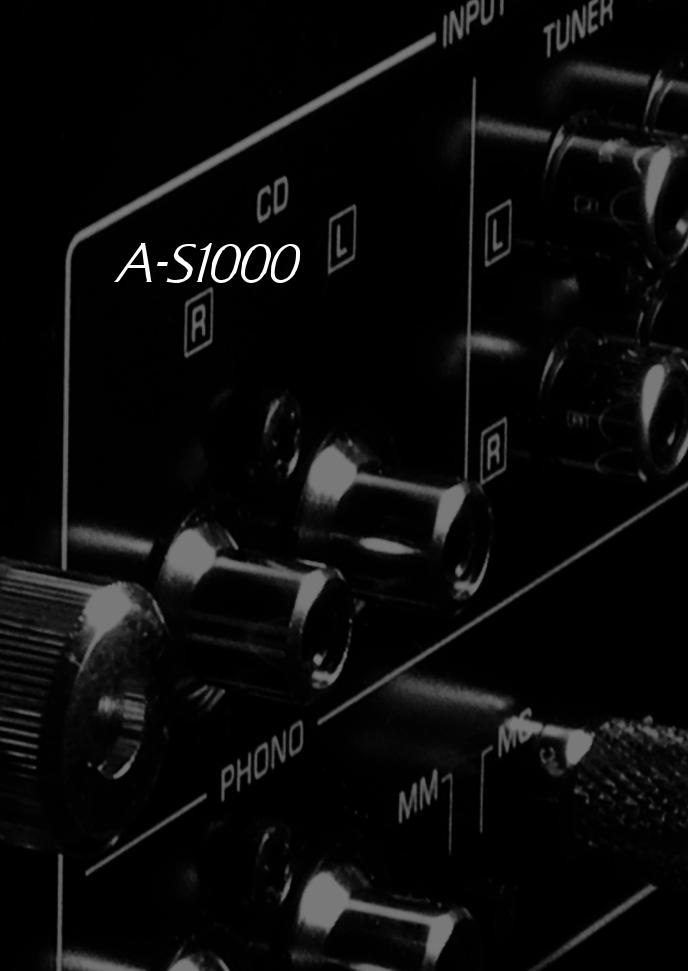
Connections
In this section, you will make connections between A-S1000, speakers, and source components.
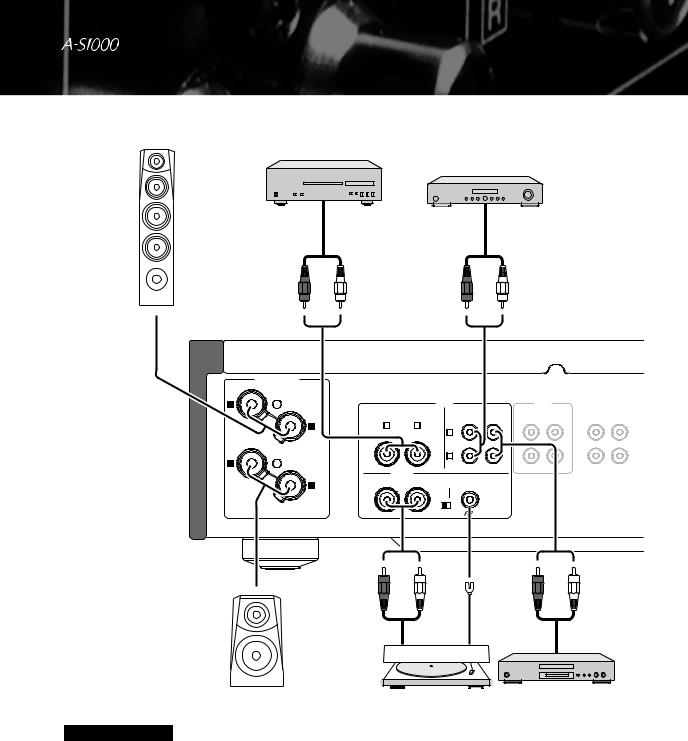
Connections
Speakers A (R channel)
CD player
Tuner
+ -
-
SPEAKERS R CH |
|
|
|
|
|
A |
INPUT |
|
|
LINE2 |
MAIN IN PRE OUT |
CD |
|
TUNER LINE 1 |
PB |
REC |
|
R |
L |
|
|
|
|
|
L |
|
|
|
|
|
R |
|
|
|
|
B |
|
|
|
|
|
PHONO |
|
|
|
|
|
|
MM |
MC |
|
|
|
|
|
GND |
|
|
|
+ -
-
Ground
Speakers B (R channel)
Turntable |
DVD player, |
|
etc. |
||
|
Caution
•If you use two sets (A and B), the impedance of each speaker must be 8 Ω or higher. When only using one set of speakers (A or B), use speakers with an impedance of 4 Ω or higher.
•Do not let the bare speaker wires touch each other or do not let them touch any metal part of this unit. This could damage this unit and/or the speakers.
•All connections must be correct: L (left) to L, R (right) to R, “+” to “+”, and “–” to “–”. If the connections are faulty, no sound will be heard from the speakers, and if the polarity of the speaker connections is incorrect, the sound will be unnatural and lack bass. Also, refer to the owner’s manual for each of your components.
•Connect your turntable to the GND terminal to reduce noise in the signal. However, you may hear less noise without the connection to the GND terminal for some turntables.
14 En
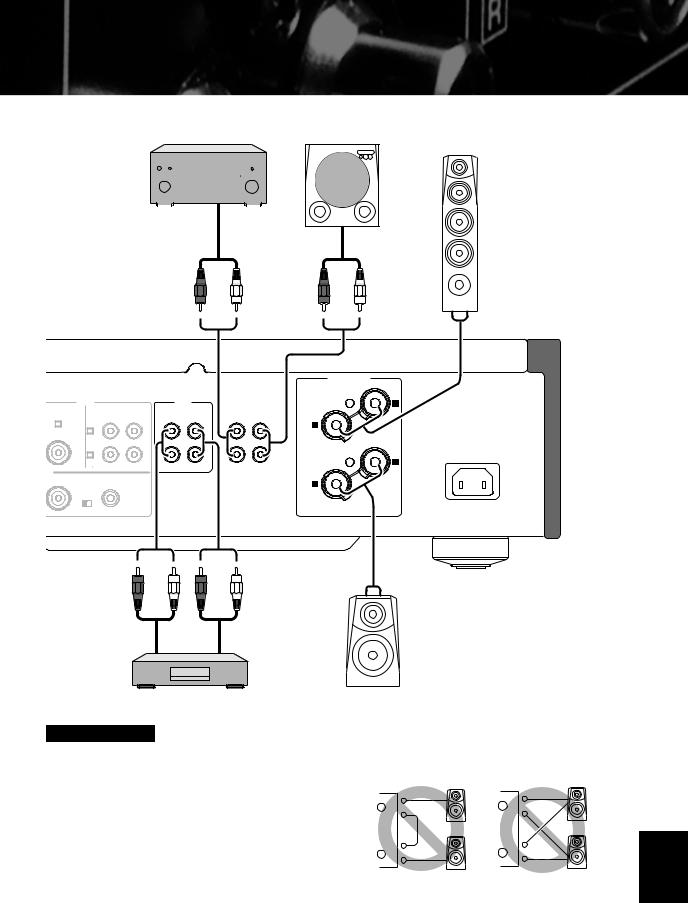
|
|
Preamplifier, |
|
External amplifier or |
|||
AV receiver, etc. |
|
active subwoofer |
|||||
|
|
|
|
|
|
|
|
|
|
|
|
|
|
|
|
|
|
|
|
|
|
|
|
|
|
|
|
|
|
|
|
|
|
|
|
|
|
|
|
|
|
|
|
|
|
|
|
Pre-out
Speakers A (L channel)
- |
+ |
|
|
|
SPEAKERS L CH |
INPUT |
|
LINE2 |
A |
TUNER LINE 1 |
PB |
REC |
MAIN IN PRE OUT |
L |
|
|
|
|
L |
|
|
|
R |
|
AC IN |
|
|
B |
|
|
|
|
|
NO |
|
|
|
MM |
MC |
|
|
|
GND |
|
|
|
|
– |
+ |
|
Output |
Input |
|
CD recorder, tape deck, etc.
Caution
•Because the power amplifier of A-S1000 is of the floating balanced type, the following types of connections are not possible:
–Connecting with the left channel “–” terminal and the right channel “–” terminal as well as “+” terminals (Fig. 1).
–Deliberately connecting with the left/right channel “–” terminals and metal part on the rear panel of this unit, as well as accidentally touching them.
–Connecting with the left channel “–” terminal and the right channel “–” terminal inverted (cross connection, Fig. 2).
•Do not connect your active subwoofer to the SPEAKERS L/R CH terminal. Connect it to the PRE OUT jacks of this unit.
Speakers B (L channel)
Fig. 1 |
Fig. 2 |
+ |
+ |
L |
L |
– |
– |
– |
– |
R |
R |
+ |
+ |
English
15 En
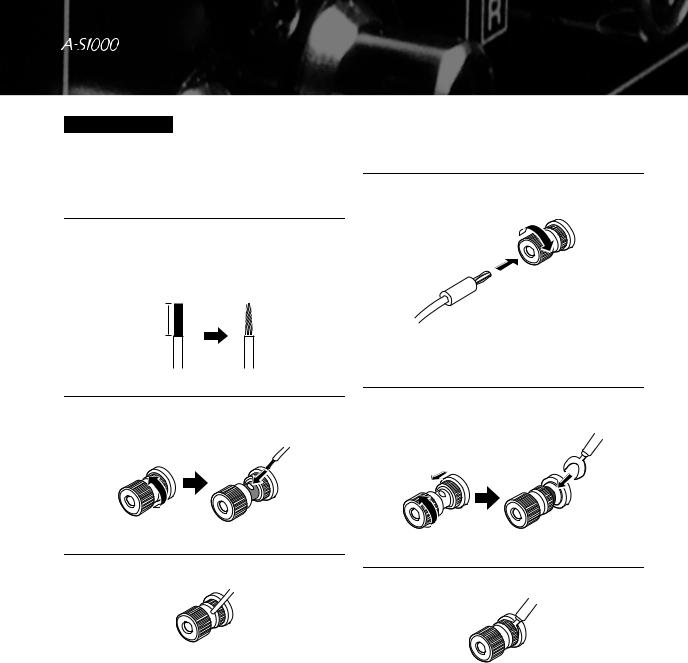
Connections
Caution
If you use two sets (A and B), the impedance of each speaker must be 8 Ω or higher. When only using one set of speakers (A or B), use speakers with an impedance of 4 Ω or higher.
■ Connecting the speakers
1Remove approximately 10 mm (0.4 in) of insulation from the end of each speaker cable and twist the exposed wires of the cable together to prevent short circuits.
10 mm (0.4 in)
2Unscrew the knob and then insert the bare wire into the hole.
3 Tighten the knob.
■Connecting the speakers using the banana plug
(Except for Europe models)
First, tighten the knob and then insert the banana plug into the end of the corresponding terminal.
Banana plug
■Connecting the speakers using the Y-shaped lug
1Unscrew the knob and then sandwich the Y-shaped lug between the ring part and base.
Y-shaped lug
Slide
2 Tighten the knob.
16 En
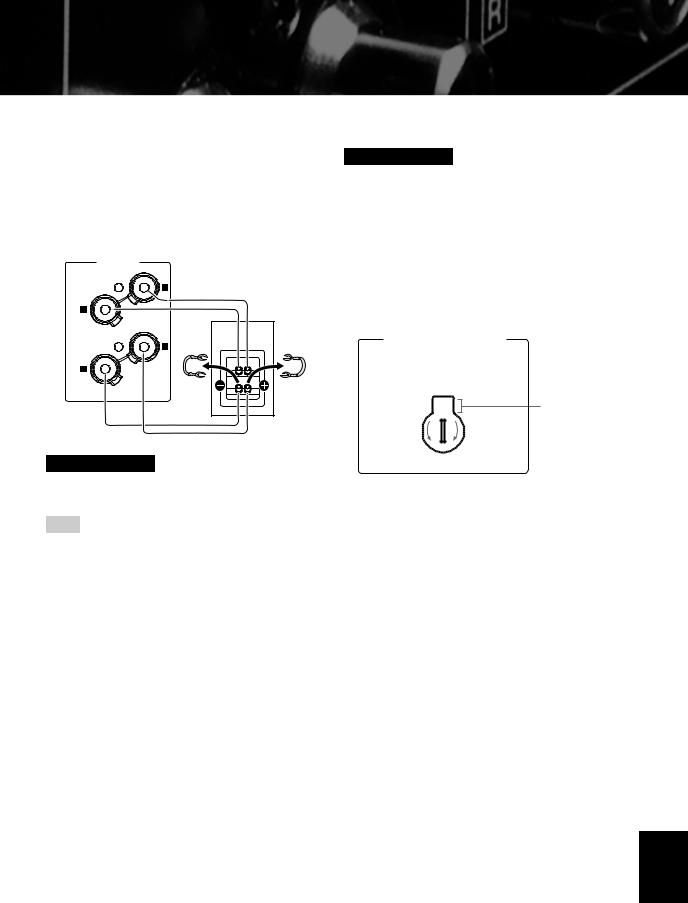
■ Bi-wire connection
The bi-wire connection separates the woofer from the combined midrange and tweeter section. A bi-wire compatible speaker has four binding post terminals. These two sets of terminals allow the speaker to be split into two independent sections. With these connections, the mid and high frequency drivers are connected to one set of terminals and the low frequency driver to another set of terminals.
SPEAKERS L CH
A
B
Caution
When making bi-wiring connections, use speakers with an impedance of 4 Ω or higher.
■VOLTAGE SELECTOR
(Asia and General models only)
Caution
The VOLTAGE SELECTOR on the rear panel of this unit must be set for your local voltage BEFORE plugging the power cable into the AC wall outlet. Improper setting of the VOLTAGE SELECTOR may cause damage to this unit and create a potential fire hazard.
Rotate the VOLTAGE SELECTOR clockwise or counterclockwise to the correct position using a straight slot screwdriver.
Voltages are as follows:
........................ AC 110/120/220/230–240 V, 50/60 Hz
VOLTAGE SELECTOR
230- |
Voltage |
240V |
|
|
indication |
Note
When making bi-wiring connections, remove the shorting bridges or cables on the speaker.
y
To use the bi-wire connections, switch the SPEAKERS selector to the A+B BI-WIRING position.
■ Connecting the power cable
Connect the power cable into the AC IN inlet on the rear panel when all connections are complete, and then plug in the power cable to the AC wall outlet.
English
17 En
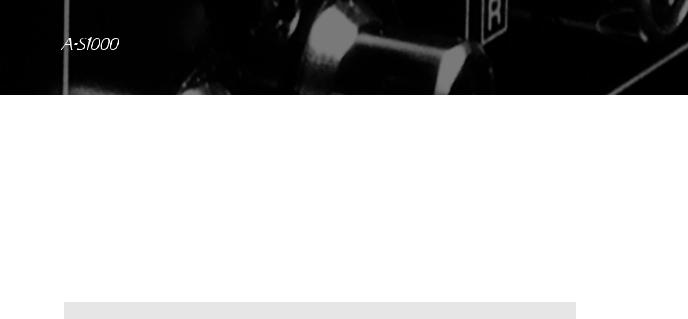
Connections
■ A-S1000 input/output table
|
CD |
PHONO |
TUNER |
LINE1 |
LINE2 |
MAIN |
Note |
|
|
DIRECT |
|||||||
|
|
|
|
|
|
|
||
|
|
|
|
|
|
|
|
|
|
|
|
|
|
|
|
|
|
SPEAKERS |
CD |
PHONO |
TUNER |
LINE1 |
LINE2 PB |
MAIN IN |
No signal is output while the SPEAKERS |
|
selector is switched to the OFF position. |
||||||||
|
|
|
|
|
|
|
No signal is output at the SPEAKERS |
|
PHONES |
CD |
PHONO |
TUNER |
LINE1 |
LINE2 PB |
– |
terminals and PRE OUT jacks while |
|
(Headphones) |
headphones are connected to the |
|||||||
|
|
|
|
|
|
|||
|
|
|
|
|
|
|
PHONES jack. |
|
|
|
|
|
|
|
|
|
|
PRE OUT |
CD |
PHONO |
TUNER |
LINE1 |
LINE2 PB |
– |
|
|
|
|
|
|
|
|
|
|
|
LINE2 REC |
CD |
PHONO |
TUNER |
LINE1 |
– |
– |
|
|
|
|
|
|
|
|
|
|
The shaded area indicates that the BASS, TREBLE, BALANCE, and VOLUME controls are ineffective.
18 En
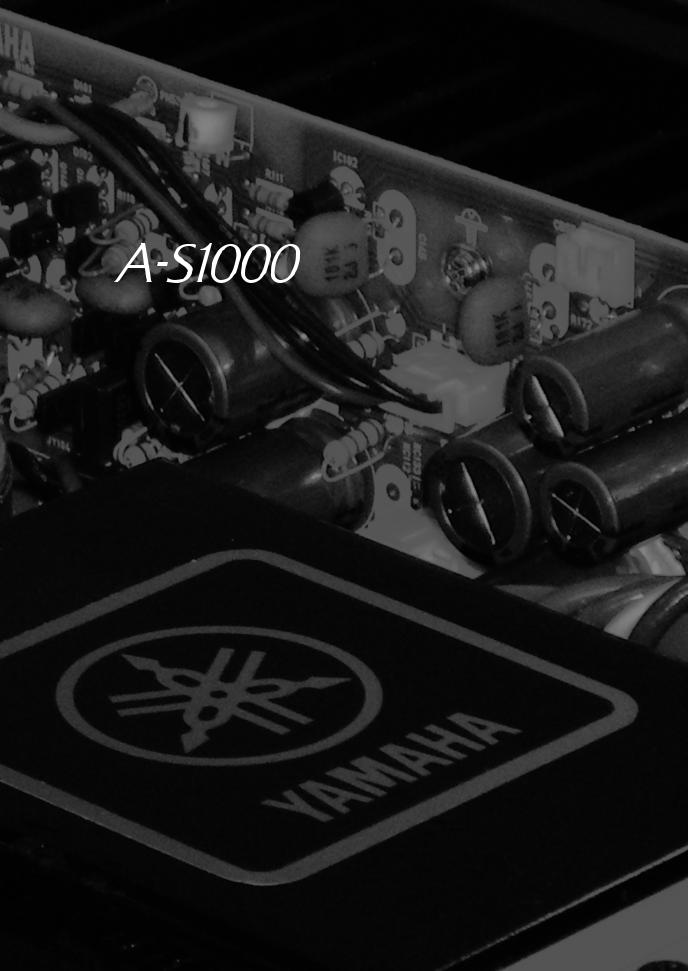
Specifications
In this section, you will find technical specifications for A-S1000.

Specifications
POWER SECTION
• Minimum RMS Output Power |
|
(8 Ω , 20 Hz to 20 kHz, 0.02% THD) |
...................... 90 W + 90 W |
(6 Ω , 20 Hz to 20 kHz, 0.02% THD) .................. |
105 W + 105 W |
(4 Ω , 20 Hz to 20 kHz, 0.02% THD) .................. |
140 W + 140 W |
• Dynamic Power (IHF) (8/6/4/2 Ω) ................... |
105/135/190/220 W |
• Maximum Output Power
(1 kHz, 0.7% THD, 4 Ω) [U.K. and Europe models only]
.......................................................................................... |
160 W |
• Maximum Useful Output Power (JEITA) |
|
(1 kHz, 10% THD, 8/4 Ω) |
|
[Asia, General, China and Korea models only] ....... |
115/190 W |
• Dynamic Headroom |
|
8 Ω ..................................................................................... |
0.67 dB |
• IEC Output Power [U.K. and Europe models only] |
|
(1 kHz, 0.02% THD, 8/4 Ω)............................................ |
90/145 W |
• Damping Factor |
|
1 kHz, 8 Ω ................................................................................ |
160 |
• Maximum Input Signal |
|
CD, etc. ................................................................................. |
2.8 V |
PHONO MM (1 kHz) ........................................................ |
120 mV |
PHONO MC (1 kHz) ............................................................ |
7 mV |
• Frequency Response |
+0/−3 dB |
CD, etc. (Flat Position, 5 Hz to 100 kHz) ...................... |
|
CD, etc. (Flat Position, 20 Hz to 20 kHz) ................... |
+0/−0.3 dB |
• RIAA Equalization Deviation |
|
PHONO MM (20 Hz to 20 kHz) ...................................... |
±0.5 dB |
PHONO MC (20 Hz to 20 kHz) ....................................... |
±0.5 dB |
• Total Harmonic Distortion |
|
CD, etc. to SP OUT |
|
(20 Hz to 20 kHz, 90 W/8 Ω) ........................................... |
0.015% |
PHONO MM to REC |
|
(20 Hz to 20 kHz, 2 V) ..................................................... |
0.005% |
PHONO MC to REC |
|
(20 Hz to 20 kHz, 2 V) ....................................................... |
0.05% |
• Intermodulation Distortion |
|
CD, etc. to SP OUT |
|
(Rated output, 8 Ω) ............................................................ |
0.02% |
• Signal to Noise Ratio (IHF-A Network) |
|
CD, etc. (150 mV, Input shorted) .......................................... |
98 dB |
PHONO MM (5 mV, Input shorted) ..................................... |
93 dB |
PHONO MC (500 µV, Input shorted) .................................. |
85 dB |
• Residual Noise (IHF-A Network) .......................................... |
73 µV |
CONTROL SECTION
• Input Sensitivity/Input Impedance |
150 mV/47 kΩ |
CD, etc. .................................................................. |
|
MM ......................................................................... |
2.5 mV/47 kΩ |
MC ........................................................................... |
100 µV/50 Ω |
MAIN IN ...................................................................... |
1 V/47 kΩ |
• Output Level/Output Impedance |
150 mV/1.5 kΩ |
REC OUT ............................................................. |
|
PRE OUT ..................................................................... |
1 V/1.5 kΩ |
• Headphone Rated Output |
|
1 kHz, 32 Ω , 0.2% THD ................................................... |
23 mW |
• Channel Separation |
|
CD, etc. (5.1 kΩ Terminated, 1 kHz/10 kHz) ................. |
74/54 dB |
PHONO MM (Input shorted, 1 kHz/10 kHz, Vol.:−30 dB) |
|
....................................................................................... |
90/77 dB |
PHONO MC (Input shorted, 1 kHz/10 kHz, Vol.:−30 dB) |
|
....................................................................................... |
66/65 dB |
• Tone Control Characteristics |
|
BASS |
|
Boost/Cut (50 Hz) ............................................................. |
±9 dB |
Turnover Frequency ........................................................ |
350 Hz |
TREBLE |
|
Boost/Cut (20 kHz) ........................................................... |
±9 dB |
Turnover Frequency ....................................................... |
3.5 kHz |
• Audio muting......................................................... |
–20 dB (approx.) |
GENERAL
• Power Supply |
|
|
|
[U.S.A. and Canada models] |
............................. AC 120 V, 60 Hz |
||
[Asia model] .................................. |
|
AC 220/230–240 V, 50/60 Hz |
|
[General model] ............... |
AC 110/120/220/230–240 V, 50/60 Hz |
||
[China model] .................................................... |
|
AC 220 V, 50 Hz |
|
[Korea model] .................................................... |
|
AC 220 V, 60 Hz |
|
[Australia model] ............................................... |
|
AC 240 V, 50 Hz |
|
[U.K. and Europe models] ................................. |
|
AC 230 V, 50 Hz |
|
• Power consumption ................................................................ |
|
350 |
W |
• Idling power consumption ......................................................... |
|
80 |
W |
• Off-state power consumption |
...................................................... |
0 |
W |
• Dimensions (W x H x D) ................................. |
|
435 x 137 x 465 mm |
|
|
|
(17 - 1/8” x 5-3/8” x 18-5/16”) |
|
• Weight ............................................................... |
|
22 kg (48 lbs. 8 oz.) |
|
* Specifications are subject to change without notice.
20 En
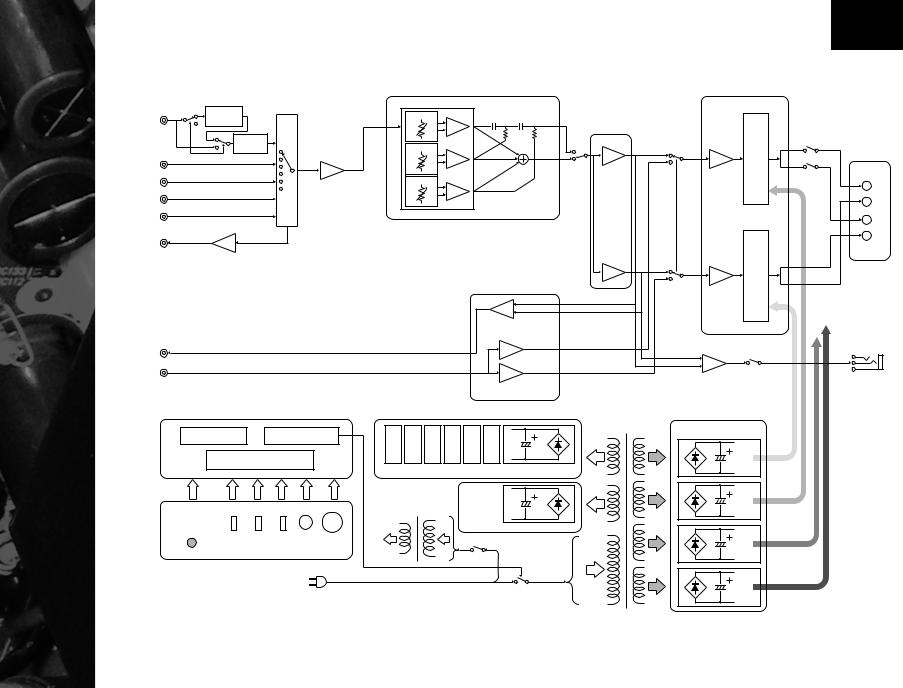
English
■ Block diagram
|
|
INPUT |
PHONO |
MC |
SELECTOR |
|
||
|
HEAD AMP |
|
|
EQ AMP |
|
CD |
MM/MC |
BUFFER AMP |
|
TUNER
LINE1
LINE2 PB
LINE2 REC
BUFFER AMP
PRE OUT
MAIN IN
PROTECTION |
CONTROL |
COM
|
TREBLE |
INPUT SEL |
|
BASS |
BALANCE |
VOLUME |
|
REMOTE
FRONT PANEL
VOLUME & TONE CONTROL |
|
|
FLOATING BALANCE |
|
ATT. 1 |
|
|
POWER AMPLIFIER |
|
|
|
|
|
|
TONE CONTROL DEVICES |
|
|
|
PHASE)SIDE |
ATT. 2 |
HOT |
|
DRIVER |
|
|
|
|
|
|
FLAT |
|
DIRECTMAIN |
DRIVERSPEAKERSPEAKER |
SIDEPHASE)(NEGATIVECOLD HOT (POSITIVE |
BALANCEUNBALANCE |
|
|||
ATT. 3 |
|
|
|
|
|
CONVERTER |
|
|
|
|
COLD |
|
|
|
|
|
|
HEADPHONE AMP |
|
BALANCE UNBALANCE |
|
|
|
|
CONVERTER |
|
|
|
|
AMPMCfor |
AMPEQfor |
AMP1LINEfor |
AMP2LINEfor |
VOLUME1for |
VOLUME2for |
MAIN TRANSFORMER |
INDEPENDENT FLOATING |
|
POWER SUPPLY |
||||||
|
|
|
|
|
|
|
|
|
|
|
|
|
|
|
L CH |
|
INDEPENDENT REGULATED POWER SUPPLY (for AUDIO) |
|
for HOT |
||||
|
|
|
|||||
|
|
|
|
|
|
|
L CH |
SUB TRANSFORMER |
|
|
|
|
for COLD |
||
|
|
|
|
|
|
|
|
COM |
|
|
|
(for POWER AMP / VOLTAGE AMP STAGE) |
|
R CH |
|
|
|
|
|
|
|
||
|
|
|
POWER SWITCH |
|
|
||
for |
|
|
|
|
|
|
for HOT |
|
|
|
|
|
|
|
|
|
|
|
|
|
|
|
R CH |
|
|
|
|
|
|
|
for COLD |
SP A L CH
SP B L CH |
SPEAKERS L CH |
+
A
–
+
– B
to POWER AMP R CH
PHONES
21 En
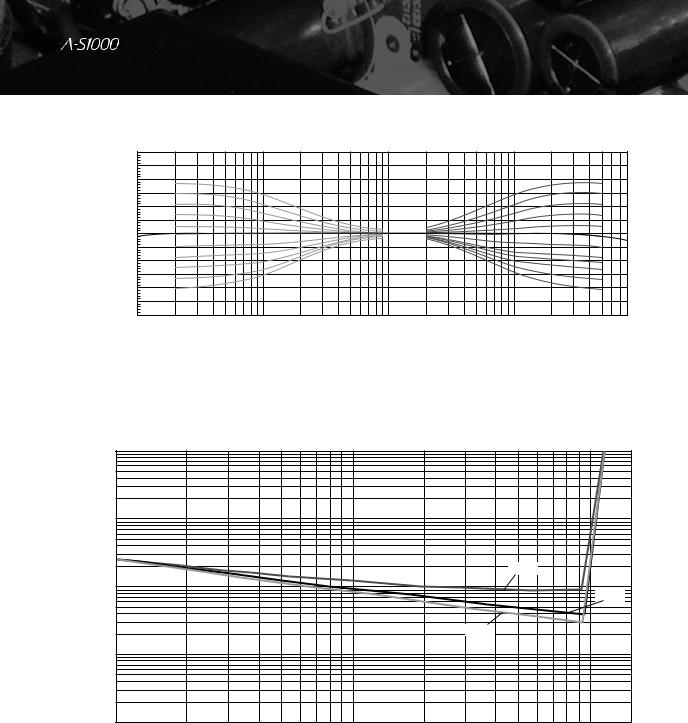
Specifications
■ Tone control characteristics
Response (dB)
+15
+12.5
+10
+7.5
+5
+2.5
0
–2.5
–5
–7.5
–10
–12.5
–15
10 |
20 |
50 |
100 |
200 |
500 |
1k |
2k |
5k |
10k |
20k |
50k |
100k |
Frequency (Hz)
■ Total harmonic distortion
|
1 |
|
|
|
|
|
|
0.5 |
|
|
|
|
|
|
0.2 |
|
|
|
|
|
|
0.1 |
|
|
|
|
|
(%) |
0.05 |
|
|
|
|
|
|
|
|
|
|
|
|
N Ratio |
0.02 |
|
|
|
20kHz |
|
0.01 |
|
|
|
|
|
|
+ |
|
|
|
|
|
|
|
|
|
|
|
20Hz |
|
THD |
|
|
|
|
|
|
0.005 |
|
|
|
|
|
|
|
|
|
|
|
|
|
|
0.002 |
|
|
|
1kHz |
|
|
|
|
|
|
|
|
|
0.001 |
|
|
|
|
|
|
0.0005 |
|
|
|
|
|
|
0.0002 |
|
|
|
|
|
|
0.0001 |
|
|
20 |
50 |
100 |
|
2 |
5 |
10 |
Output (W)
22 En
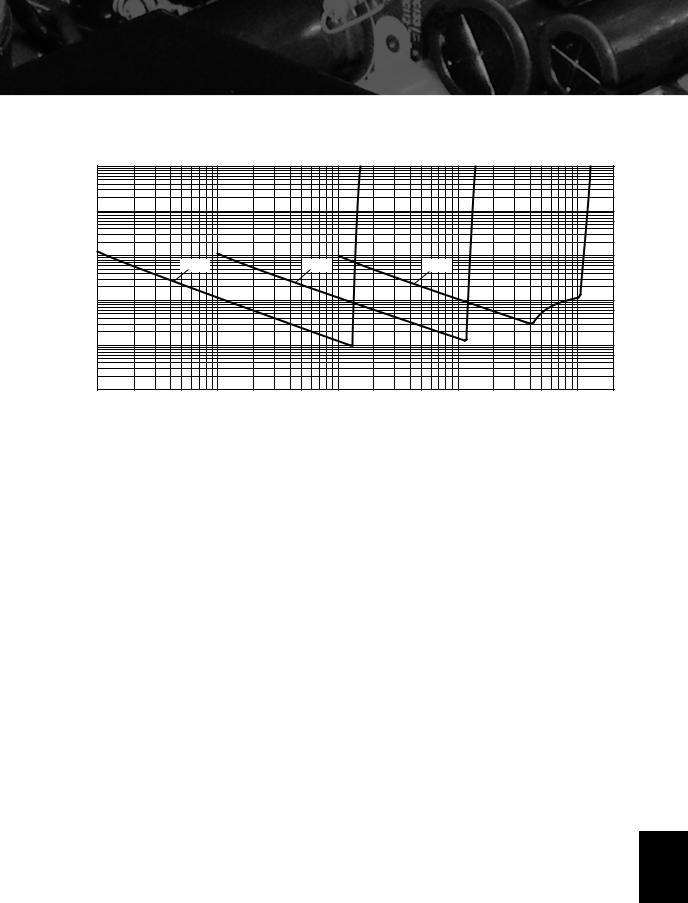
■ Total harmonic distortion (PHONO)
|
10 |
|
|
|
|
|
|
|
|
|
|
|
|
|
|
5 |
|
|
|
|
|
|
|
|
|
|
|
|
|
|
2 |
|
|
|
|
|
|
|
|
|
|
|
|
|
|
1 |
|
|
|
|
|
|
|
|
|
|
|
|
|
|
0.5 |
|
|
|
|
|
|
|
|
|
|
|
|
|
(%) |
0.2 |
|
|
|
|
|
|
|
|
|
|
|
|
|
0.1 |
|
|
|
|
|
|
|
|
|
|
|
|
|
|
+ N Ratio |
|
|
|
|
|
|
|
|
|
|
|
|
|
|
0.05 |
|
20Hz |
|
|
1kHz |
|
|
20kHz |
|
|
|
|
||
0.02 |
|
|
|
|
|
|
|
|
|
|
|
|
|
|
THD |
0.01 |
|
|
|
|
|
|
|
|
|
|
|
|
|
0.005 |
|
|
|
|
|
|
|
|
|
|
|
|
|
|
|
|
|
|
|
|
|
|
|
|
|
|
|
|
|
|
0.002 |
|
|
|
|
|
|
|
|
|
|
|
|
|
|
0.001 |
|
|
|
|
|
|
|
|
|
|
|
|
|
|
0.0005 |
|
|
|
|
|
|
|
|
|
|
|
|
|
|
0.0002 |
|
|
|
|
|
|
|
|
|
|
|
|
|
|
0.0001 |
|
|
|
|
|
|
|
|
|
|
|
|
|
|
100µ |
200µ |
500µ |
1m |
2m |
5m |
10m |
20m |
50m |
100m |
200m |
500m |
1 |
2 |
Input (Vrms)
English
23 En

Troubleshooting
Refer to the chart below if this unit does not function properly. If the problem you are experiencing is not listed below or if the instructions below do not help, turn off this unit, disconnect the power cable, and contact the nearest authorized Yamaha dealer or service center.
Problem |
Cause |
Remedy |
See |
|
page |
||||
|
|
|
||
|
|
|
|
|
This unit fails to turn |
The power cable is not connected to the |
Connect the power cable firmly. |
17 |
|
on. |
AC IN inlet on the rear panel or not |
|
||
|
plugged in the AC wall outlet. |
|
|
|
|
|
|
|
|
|
The protection circuitry has been activated |
Check that the speaker wires are not touching each |
14 |
|
|
because of a short circuit, etc. |
other or shorting out against the rear panel of this |
||
|
|
unit, and then turn the power of this unit back on. |
|
|
|
|
|
|
|
|
This unit has been exposed to a strong |
Turn off this unit, disconnect the power cable, plug it |
— |
|
|
external electric shock (such as lightning |
back in after 30 seconds, and then use it normally. |
||
|
or strong static electricity). |
|
|
|
|
|
|
|
|
The POWER indicator |
The protection circuitry has been activated |
Check that the speaker wires are not touching each |
14 |
|
on the front panel |
because of a short circuit, etc. |
other or shorting out against the rear panel of this |
||
flashes. |
|
unit, and then turn the power of this unit back on. |
|
|
|
|
|
|
|
|
There is a problem with the internal |
Disconnect the power cable and contact the nearest |
— |
|
|
circuitries of this unit. |
authorized Yamaha dealer or service center. |
||
|
|
|||
|
|
|
|
|
The INPUT indicator |
The protection circuitry has been activated |
Check that the speaker wires are not touching each |
|
|
on the front panel |
because of a short circuit, etc. |
other or shorting out against the rear panel of this |
|
|
flashes and the |
|
unit, and then turn the power of this unit back on. |
14 |
|
volume is turned |
|
|
||
|
|
|
||
down when you turn |
|
|
|
|
on this unit. |
|
|
|
|
|
|
|
|
|
No sound. |
Incorrect input or output cable |
Connect the cables properly. If the problem persists, |
14 |
|
|
connections. |
the cables may be defective. |
||
|
|
|||
|
|
|
|
|
|
No appropriate input source has been |
Select an appropriate input source with the INPUT |
9, 12 |
|
|
selected. |
selector on the front panel (or one of the input |
||
|
|
selector buttons on the remote control). |
|
|
|
|
|
|
|
|
The SPEAKERS switch is not set |
Switch the SPEAKERS switch to the appropriate |
7 |
|
|
properly. |
position. |
||
|
|
|||
|
|
|
|
|
|
Speaker connections are not secure. |
Secure the connections. |
14 |
|
|
|
|
|
|
The sound suddenly |
The protection circuitry has been activated |
Check that the speaker wires are not touching each |
14 |
|
goes off. |
because of a short circuit, etc. |
other or shorting out against the rear panel of this |
||
|
|
unit, and then turn the power of this unit back on. |
|
|
|
|
|
|
|
Only the speaker on |
Incorrect cable connections. |
Connect the cables properly. If the problem persists, |
14 |
|
one side can be |
|
the cables may be defective. |
||
|
|
|||
heard. |
|
|
|
|
Incorrect setting for the BALANCE |
Set the BALANCE control to the appropriate |
8 |
||
|
||||
|
control. |
position. |
||
|
|
|||
|
|
|
|
|
There is a lack of bass |
The + and – wires are connected in |
Connect the speaker wires to the correct + and – |
14 |
|
and no ambience. |
reverse at the amplifier or the speakers. |
phase. |
||
|
||||
|
|
|
|
|
A “humming” sound |
Incorrect cable connections. |
Connect the audio cable plugs firmly. If the problem |
14 |
|
is heard. |
|
persists, the cables may be defective. |
||
|
|
|||
|
|
|
|
|
|
No connection from the turntable to the |
Connect the turntable to the GND terminal of this |
14 |
|
|
GND terminal. |
unit. |
||
|
|
|||
|
|
|
|
24 En
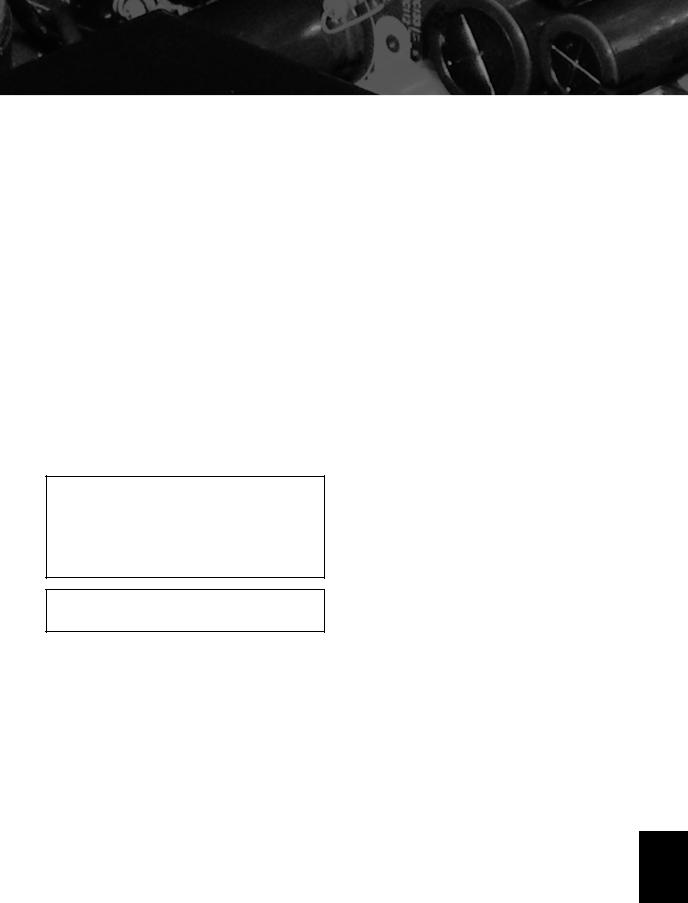
Problem |
Cause |
Remedy |
See |
|
page |
||||
|
|
|
||
|
|
|
|
|
The volume level is |
The turntable is connected to the jacks |
Connect the turntable to the PHONO jacks. |
11 |
|
low while playing a |
other than the PHONO jacks. |
|
||
|
|
|||
record. |
|
|
|
|
Incorrect setting for the PHONO switch |
Switch the PHONO switch to the MM or MC position |
11 |
||
|
||||
|
on the rear panel. |
according to the type of magnetic cartridge of the |
||
|
|
turntable. |
|
|
|
|
|
|
|
The sound is |
The power of this unit is turned off. |
Turn on the power of this unit. |
|
|
degraded when |
|
|
|
|
listening with the |
|
|
6 |
|
headphones |
|
|
||
connected to the CD |
|
|
|
|
player connected to |
|
|
|
|
this unit. |
|
|
|
|
|
|
|
|
|
The remote control |
Wrong distance or angle. |
The remote control functions within a maximum |
6 |
|
does not work or |
|
range of 6 m (20 ft) and no more than 30 degrees off- |
||
function properly. |
|
axis from the front panel. |
|
|
|
|
|
|
|
|
Direct sunlight or lighting (from an |
Reposition this unit. |
|
|
|
inverter type of fluorescent lamp, etc.) is |
|
— |
|
|
striking the remote control sensor of this |
|
||
|
|
|
||
|
unit. |
|
|
|
|
|
|
|
|
|
The batteries are weak. |
Replace all batteries. |
12 |
|
|
|
|
|
Taking care of this unit
When you wipe this unit, do not use chemical solvents (ex. alcohol or thinner, etc.); this might damage the finish. Use a clean, dry cloth. For heavy dirt, dampen a soft cloth in detergent diluted with the water, wring it out, and then clean this unit up with the cloth.
The screws on the side panels may loosen as wood expands and contracts. In this case, tighten the screws.
English
25 En
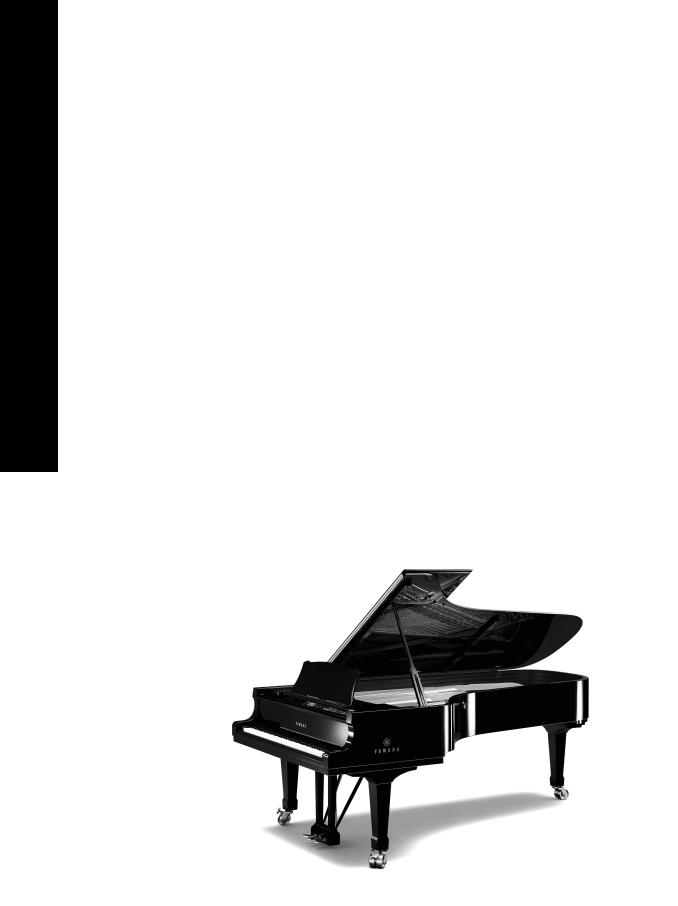
La Hi-Fi doit ses débuts à Yamaha
La passion de Yamaha pour la musique remonte à plus d’un siècle, plus exactement à 1887, l’année où nous avons conçu notre première orgue à anche. Actuellement, nous sommes le principal producteur de pianos et d’instruments de musique au monde, et nous sommes impliqués de multiples façons dans le domaine musical. Nous fabriquons des équipements d’enregistrement professionnels, nous concevons des salles de concert et assistons les artistes à effectuer réglages et accordage sonores pour les concerts.
Notre production de composants audio profite de maintes manières de ce savoir et de cette expérience. Nous avons commercialisé notre premier tourne-disque Hi-Fi (Haute Fidélité) en 1955. Nous avons été ensuite une des premières sociétés à produire en masse des appareils audio de haute qualité et à introduire d’innombrables composants stéréo légendaires.
Nous espérons que vous apprécierez l’expérience Hi-Fi unique du Yamaha Natural Sound.
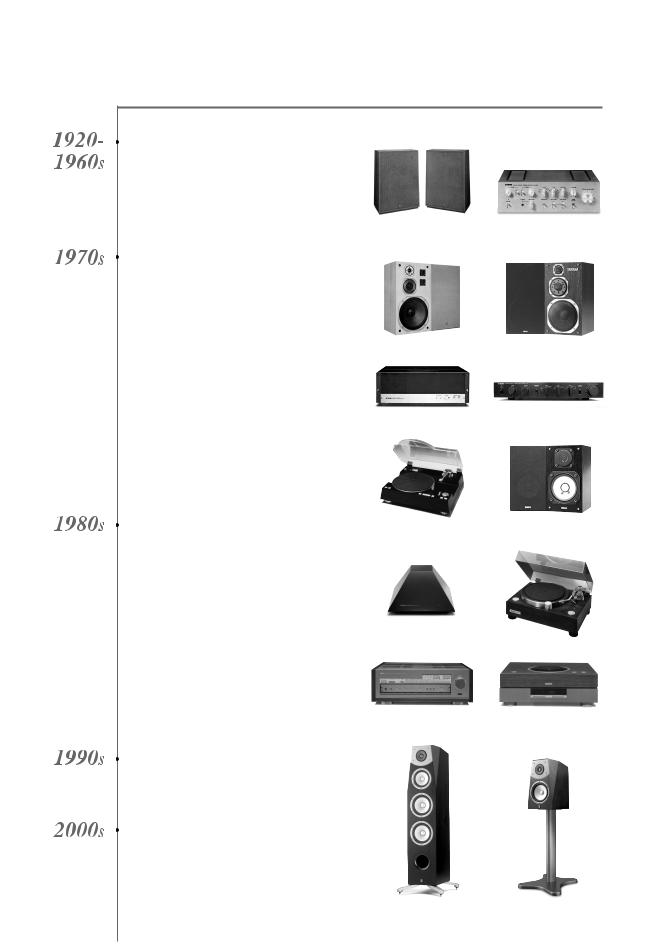
L’excellence dans l’accomplissement audio
922: Nous avons commercialisé un phonographe à manivelle de haute qualité.
Depuis 1955, nous avons introduit de nombreux composants Hi-Fi, en particulier des tourne-disques, tuners, amplificateurs intégrés, préamplis, amplificateurs de puissance et enceintes.
Enceinte de contrôle NS-20
Amplificateur intégré CA-1000
Faisant partie des appareils de Classe A, le CA-1000 devient un standard en matière d’amplificateurs intégrés.
Enceinte de contrôle NS-690
Enceinte de contrôle NS-1000M
Une enceinte véritablement légendaire, toujours vénérée par les passionnés de Hi-Fi
NS-20 |
CA-1000 |
NS-690 |
NS-1000M |
Amplificateur de puissance B-1
Un ampli innovant utilisant des transistors FET à tous les étages
Amplificateur de commande C-2
A reçu le premier prix au Salon International de la Musique et de la Hi-Fi de Milan. B-1
Enceinte de contrôle pour studio NS-10M
Devenue une des enceintes de studio les plus populaires au monde.
Amplificateur intégré A-1
Tourne-disque PX-1
Le premier tourne-disque à alignement linéaire Yamaha
Amplificateur de puissance B-6 |
PX-1 |
|
Un amplificateur de puissance en pyramide à alimentation X et amplificateur X
Tourne-disque GT-2000/L
Un lecteur lourd ultraprécis au concept GT
Lecteur de CD CD-1
Premier lecteur de CD commercialisé en 1983
B-6
Amplificateur de puissance B-2x
Amplificateur de puissance MX-10000 et Amplificateur de commande CX-10000
Des amplificateurs qui ont redéfini les capacités des composants
Modèles à l’ocassion du 100e anniversaire
AX-2000
Amplificateur intégré AX-2000
À rapport S/B élevé (128 dB) et son numérique direct
Lecteur de CD GT-CD1
Un lecteur à chargement par le haut et structure séparée intégrée
Amplificateur de puissance MX-1 et
Amplificateur de commande CX-1
Systèmes d’enceintes Natural Sound
Soavo-1 et Soavo-2
Amplificateur stéréo A-S2000 et Lecteur de Super Audio CD CD-S2000
Amplificateur stéréo A-S1000 et Lecteur de
Soavo-1
Super Audio CD CD-S1000
C-2
NS-10M
GT-2000
GT-CD1
Soavo-2
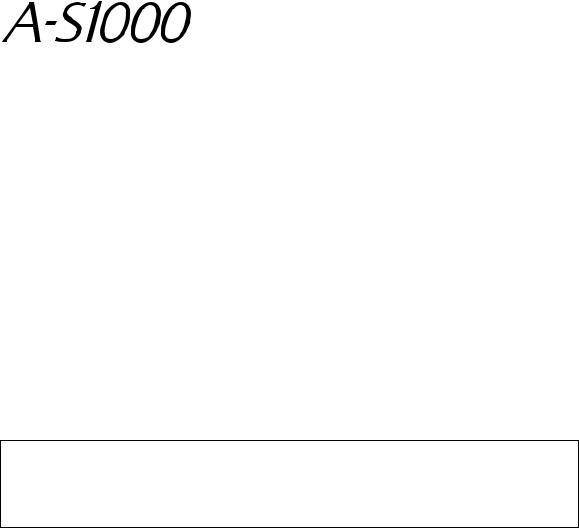
Conception des circuits à symétrie flottante
Cet amplificateur de puissance basé sur un tout nouveau circuit de type à symétrie flottante optimise les performances de l’amplificateur analogique.
Réglage de volume et de tonalité parallèle
Quatre blocs d’alimentation séparés de grande capacité
Structure symétrique horizontale
Amplificateur phono à structure entièrement discrète
Pieds lourds de type nouveau pour supprimer les vibrations
■ |
Accessoires fournis |
|
Veuillez vous assurer que tous les articles suivants vous ont bien été fournis. |
|
|
• |
Boîtier de télécommande |
|
• Piles (AA, R6, UM-3) (×2) |
|
|
• |
Cordon d’alimentation |
|
• Brochure sur la sécurité |
|
|
Table des matières |
|
|
|
Commandes et fonctions....................................................................................................................................... |
6 |
|
Raccordements .................................................................................................................................................... |
14 |
|
Caractéristiques techniques ............................................................................................................................... |
20 |
|
Guide de dépannage............................................................................................................................................ |
24 |
■ À propos de ce manuel
•Le symbole yappelle votre attention sur un conseil d’utilisation.
•Ce mode d’emploi a été imprimé avant la fabrication de l’appareil. Les caractéristiques et la présentation ont pu être modifiées à fin d’amélioration, etc. En cas de divergence entre le mode d’emploi et l’appareil, ce dernier prime.
•La couleur des images dans ce manuel peut être différente de l’original.
•Avant d’utiliser cet appareil, veuillez lire la “Brochure sur la sécurité”.
4 Fr
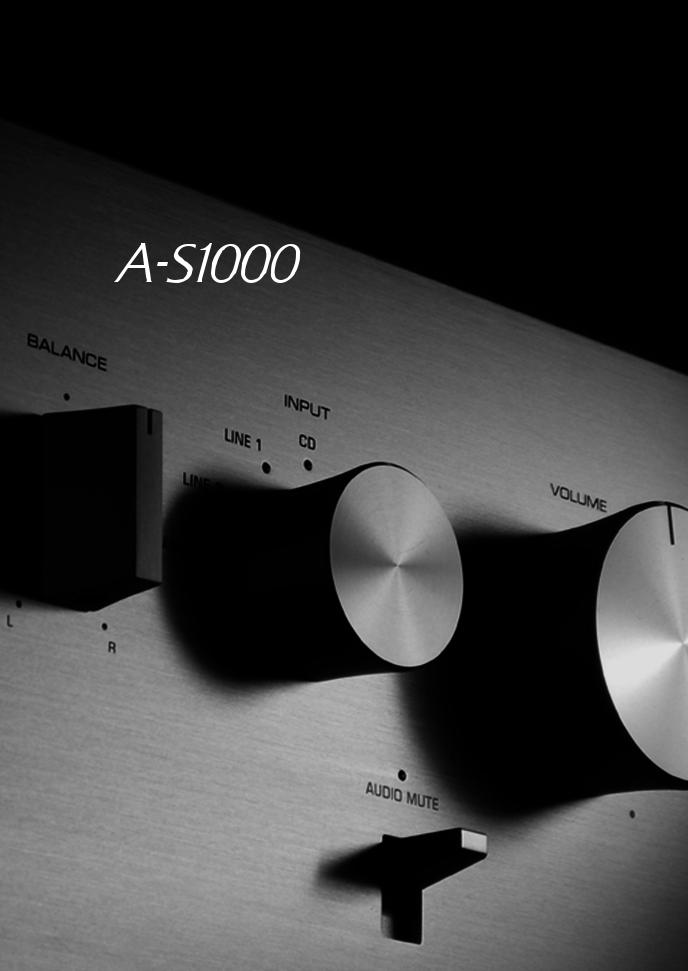
Commandes et fonctions
Ce chapitre décrit les commandes et fonctions du A-S1000.
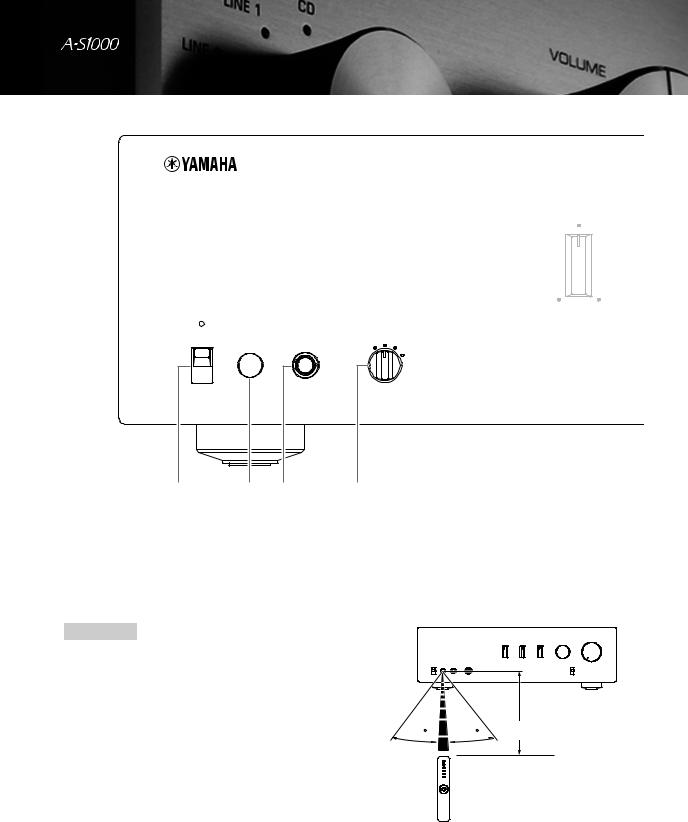
Commandes et fonctions
■ Face avant (côté gauche)
BASS
- |
+ |
POWER |
|
PHONES |
SPEAKERS |
||
ON |
|
|
OFF |
A |
B |
|
|
|
|
|
A+B |
|
|
|
|
|
BI-WIRING |
OFF |
|
|
|
|
|
1 |
2 |
3 |
4 |
|
|
1 POWER
Appuyez vers le haut ou le bas pour mettre cet appareil sous ou hors tension.
y
Le témoin POWER au-dessus de la touche s’allume lorsque cet appareil est sous tension.
2 Capteur de télécommande
Il reçoit les signaux émis par le boîtier de télécommande.
y
Le boîtier de télécommande émet un faisceau infrarouge étroit. Veillez à le pointer directement sur le capteur de télécommande de l’appareil pour en assurer le fonctionnement.
Remarques
• Si le témoin POWER clignote lorsque vous mettez cet appareil sous tension, débranchez le câble d’alimentation secteur et reportez-vous à la section dédiée au dépannage (page 24).
• Lorsque vous mettez l’appareil sous tension, il faut attendre quelques secondes pour que l’appareil puisse reproduire le son.
30 |
30 |
Environ 6 m |
|
6 Fr
